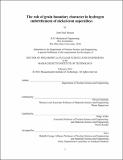| dc.contributor.advisor | Silvija Gradečak. | en_US |
| dc.contributor.author | Hanson, John Paul, Ph. D. Massachusetts Institute of Technology | en_US |
| dc.contributor.other | Massachusetts Institute of Technology. Department of Nuclear Science and Engineering. | en_US |
| dc.date.accessioned | 2017-12-05T16:25:28Z | |
| dc.date.available | 2017-12-05T16:25:28Z | |
| dc.date.copyright | 2016 | en_US |
| dc.date.issued | 2016 | en_US |
| dc.identifier.uri | http://hdl.handle.net/1721.1/112382 | |
| dc.description | Thesis: Ph. D., Massachusetts Institute of Technology, Department of Nuclear Science and Engineering, 2016. | en_US |
| dc.description | This electronic version was submitted by the student author. The certified thesis is available in the Institute Archives and Special Collections. | en_US |
| dc.description | Cataloged from student-submitted PDF version of thesis. | en_US |
| dc.description | Includes bibliographical references (pages 183-196). | en_US |
| dc.description.abstract | Hydrogen embrittlement of engineering alloys is characterized by a loss of ductility and unpredictable failure. These failures affect numerous industries, including nuclear power, oil and gas exploration, and hydrogen transportation and storage. In face-centered cubic alloys, the resultant fracture is intergranular and very sensitive to grain boundary character. We study this behavior in alloy 725, a popular nickel-iron superalloy with high strength and corrosion resistance. Using a suite of complementary experimental techniques we reveal the fracture behavior of individual grain boundaries in hydrogen embrittlement for the first time, providing critical understanding of the role of grain boundary character and informing improved microstructure design. We study crack propagation in hydrogen embrittled tensile test specimens using highenergy diffraction-microscopy, a non-destructive X-ray synchrotron technique capable of mapping grain boundaries in 3-D. We find that boundaries with low-index planes (BLIPs), defined as planes within 10° of [111], [110] or [100], resist crack propagation and improve toughness. We show that coherent twin boundaries (CTBs), a subset of BLIPs, also indirectly improve toughness by increasing the heterogeneity of the grain boundaries they intersect. In addition, we use electron backscatter diffraction and scanning electron microscopy to identify the grain boundaries along which cracks initiate and propagate on the sample surface. We unambiguously show that grain boundaries are the source of crack initiation, and we study a statistically significant number of cracking events, providing the ability to determine the role of grain boundary character. Surprisingly, we find that while CTBs resist crack propagation, they preferentially initiate cracks. These results inform a more nuanced approach to microstructure design. Typically grain boundary engineering techniques aim to maximize the fraction of low-S boundaries as designated by the coincident site lattice model. Our results suggest that these techniques should maximize the fraction of BLIPs instead. In addition, the dual nature of CTBs suggests the development of graded microstructures, with high concentrations of CTBs in the interior to resist crack propagation and reduced concentrations at the surface to limit crack initiation. | en_US |
| dc.description.statementofresponsibility | by John Paul Hanson. | en_US |
| dc.format.extent | 196 pages | en_US |
| dc.language.iso | eng | en_US |
| dc.publisher | Massachusetts Institute of Technology | en_US |
| dc.rights | MIT theses are protected by copyright. They may be viewed, downloaded, or printed from this source but further reproduction or distribution in any format is prohibited without written permission. | en_US |
| dc.rights.uri | http://dspace.mit.edu/handle/1721.1/7582 | en_US |
| dc.subject | Nuclear Science and Engineering. | en_US |
| dc.title | The role of grain boundary character in hydrogen embrittlement of nickel-iron superalloys | en_US |
| dc.type | Thesis | en_US |
| dc.description.degree | Ph. D. | en_US |
| dc.contributor.department | Massachusetts Institute of Technology. Department of Nuclear Science and Engineering | |
| dc.identifier.oclc | 1011423607 | en_US |
